Kanchenjunga
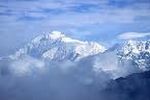
The word Kanchenjunga is of Tibetan origin which means, Five treasuries of the great snow. The world's third highest pinnacle, and the highest peak of India, Kanchenjunga is surrounded by Sikkim in the east and the south, Nepal in the west and Tibet in the north. The topmost apex of these mountain ranges is 28,156 feet high. Crowned with silvery snow, this haughty summit of Himalayas is still unconquered.
The palace exhibits an exquisite synthesis of three supreme architectural styles: Indo-Saracenic, Dravidian and Oriental Roman. Built in fine marble and granite, this three storied palace was designed by a renowned British architect Henry Irwin. The medley of pink and gray hue gives the palace a radiant look. A 145 feet tower built in five stories and embellished with golden domes enrich the veneration of this palace.
Gangtok, perched in the lap of nature against the monolithic backdrop of mighty Kanchenjunga, offers the most elegant view of the mountain ranges. Enchey Monastery and Ganesh Tok are the two forefronts that provide awe inspiring vista of this gargantuan natural wonder. Kanchenjunga, the most precious trinket in the diamond necklace of Himalaya, is worshipped as a guardian deity of the Sikkim region by the natives. Kanchenjunga, one of the most challenging peaks in the world is a favorite trekking destination for the adventure enthusiasts. Many of these trekking routs commence from Gangtok.
Tashi Viewpoint
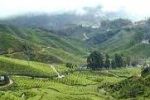
Named after 'Tashi Namgyal', the late king of Sikkim who constructed it, Tashi View point is situated along the North Sikkim Highway, about 8 kilometers from Gangtok. Astounding perspectives of magnanimous Kanchenjunga and Mt. Siniolchu can be enjoyed from here. Apart from that, Labrang Monastery and Phodong Monastery perched on the opposite hill tops and a panoramic view of Sikkim landscape are clearly beheld from this place. Another feature of Tashi Viewpoint is the Tashi Ling Monastery, widely revered for the sacred pot 'Bumchu' and 300 years old holy water placed here. The grace and glory of transcendental surroundings can best be perceived from the Tashi View Point in the early morning. A genial cafeteria and a benign shed have been set up here and a recreational park adds to the merriment of the tourists who visit Tashi Viewpoint.
Deorali Orchid Sanctuary
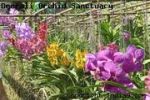
Located adjacent to the Namgyal Institute, Deorali Orchid Sanctuary is a Utopia personified. Extensive and colossal collection of rare species of Orchid amaze the spectators to no extend. As many as 454 common and rare species of Orchid found in and around Sikkim are cultivated in this wide spread sanctuary. The blooming seasons of orchids is April-May, July-August, and December-January. The noteworthy feature of this sanctuary is that the collection of Orchids varies depending upon the changing seasons. Apart from Deorali Orchid Sanctuary, there is one more destination that would interest nature lovers. Known by the name of 'Orchidarium', this orchid sanctuary is situated off the main road that leads to Rangpo. Placed beside the White Hall is the Flower Exhibition Centre that one cannot miss to visit.
Tsongo Lake
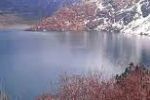
A pleasant ride of 35 kilometers on Gangtok - Nathu-la highway amidst extravagance of nature will reach you to the beautiful place called Tsongo Lake. Also known as Changu Lake, this water body is about 50 feet deep, 1 km long and is situated at the elevation of 12,000 feet. The snow that melts and gushes down the mountains forms this lake. The mystic combination of nippy, placid Lake Side in the outstanding harmony with bounteous surrounding beauty makes this place enchanting vicinity. Primulae flowers, poppies and other pristine alpine vegetation in abundance ornament the borders of the lake. Tsongo Lake usually freezes during winter. Natives believe that in olden days Buddhist Monks used to predict the future by looking at the stature and color of the lake. Natives worship this lake as their deity. On the banks of the Tsongo Lake is set up a small Shiva Temple. The tourism department of Sikkim organizes tours to this place. The best time to visit Tsongo Lake is between March and May and from September to December. You will have to obtain a prior permission to visit this lake. Foreigners are not allowed entry in these premises. And cameras are strictly prohibited here. The Tseten Tashi cave, a three storied cave is attraction multiplied here.
Do Drul Chorten
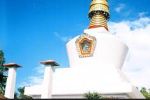
Acclaimed to be the most important Stupa of the state Sikkim, 'Do Drul Chorten' Stupa was built by Trulshi Rimpoche, the Head of the Nyingma order of Tibetan Buddhism in the year 1945. This sacred Stupa is crowned with an exorbitant gold gilded dome top which exhibits 108 prayer wheels (Mani-Lhakor). This highly esteemed Stupa is also characterized with complete Mandala sets of Dorjee Phurba, a set of Kangyur relics, complete Zung and other religious objects. The Chorten is surrounded by two majestic statues of Guru Rimpoche. Do Drul Chorten comprises a must visit religious and cultural habitat. Pilgrims from every corner of Sikkim arrive at this Chorten to pay homage.
Enchey Monastery
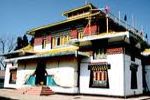
Constructed in 1840 AD, Enchey Monastery brought the ambiguous Gangtok to a bright centre state. A very important religious seat of Nyingma order, this monastery is believed to have been built on the planes that were blessed by Lama Drupthob Karpo, a tantric master recognized far and wide for his ability to fly. Enchey means 'the solitary temple'. Situated about 3 kilometers from Gangtok, Enchey Monastery was initially built by a Lama as his resident. A legend says that this Lama flew to Gangtok from Maenam Hill. The present Monastery was built up in 1909 AD and is characterized by peculiar pagoda shaped roofs. Harboring the historical, cultural and religious heritage of Sikkim, this monastery houses many images and idols of Buddhist deities. On the 18th and 19th day of the last month of lunar calendar (The month of Falgun), a grand pooja is performed at the monastery. Every year in the month of January this monastery celebrates a regal festival. Thousands of Buddhist people arrive at the monastery to participate in the festival with unlimited joy and devotion. 'Chaam' a distinct mask dance is an exclusive feature of this festival.
Phensong Monastery
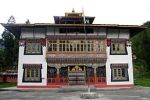
On the sloppy mountain ranges that meander from Kabi to Phodong in North Sikkim is nestled the serene and tranquil Phensong Monastery. Built during the governance of Jigme Pawo, in the year 1721, this monastery comes under the Nyingmapa order of Tibetan Buddhism. Phensong Monastery is reckoned to be one of the most sacred Buddhist pilgrimage and is noteworthy for housing nearly 300 monks. A sublime amalgamation of the pristine natural allure and the spiritual fervor makes this place a heaven on the earth.
Ganesh Tok
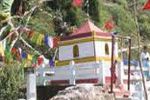
As the name clearly suggests, this sacred shrine is dedicated to Lord Ganesha. Located about 7 kilometers on Gangtok- Nathula Road on a small hillock, this temple, popularly known as Ganesha Tok, neighbors the television tower. Regarded to be a very holy and auspicious temple, this place is a must visit religious hamlet. The architecture of this temple is so small that at a time only one person can be admitted inside the sanctum to take the darshana of Lord Ganesha. Perched at the elevation of 6500 meters above sea level, this hill top offers a bird's eye view of the entire Gangtok region. The Rajbhavan complex of Gangtok, Mt. Kanchenjunga, the magnanimous crown of the city and the surrounding valley look extremely spectacular and astonishing from here. 'Smriti Van' is a garden situated near the temple where devotees of Lord Ganesha, with complete devotion plant seedling in the remembrance of there dear ones.
Hanuman Tok
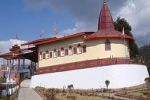
Located approximately 11 kilometers from Gangtok, hanuman Tok is nestled at the altitude of about 7200 feet. As suggested by the name, this hill top bears a temple dedicated to Lord Hanuman. Extremely tidy and well kept temple of Hanuman Tok is maintained and managed by a division of the Indian Army. A royal cremation ground known by the name of Lukshyama is located adjacent to this temple. This is the place where the mortal remains of the last descendents of the Namgyal family were put to Flames. Hanuman Tok is also popular for the breathtaking views of the entire Gangtok region and the Kanchenjunga mountain ranges that it offers.
Rumtek Monastery
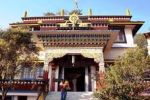
'Rumtek Monastery', also popularly known as 'Dharma Chakra' is one of the esteemed Buddhist religious destinations in Gangtok. Situated in East Sikkim about 24 kilometers from the heart of the city, Rumtek Monastery is the biggest Monastery of Gangtok. In this monastery monks perform all the sacred rituals including the practices of the Karma Kagyu lineage. As this monastery is located at the elevation of 5800 feet, the height renders the weather of this place to be very chilly and pleasant. Average temperature ranges between 13°c and 21°c. But winter is a rather cold season. During winter the temperature fluctuates around 8°c to 15°c. The golden Stupa that houses the precious relics of the Sixteenth Karmapa is the most auspicious and revered shrine of Buddhism here.
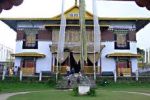
Peymangtse Monastery
Peymangtse Monastery, a highly apprised and revered Monastery of the Sikkimese, is situated about 118 kilometers from Gangtok. Perched at the altitude of 2085 meters against the opulent backdrop of snow crowned Kanchenjunga, this splendid monastery is built in wood and scintillates. The name Peymangtse means a 'Perfect Sublime Lotus' in the native language. Built by a Lama named Lhatsun Chempo, in the year 1705, this Buddhist spiritual station was believed to be the abode of the 'ta-sang' Lamas. Though, over a period of time the doors of this monastery were opened to the monks from all walks of life. The Pemayangtse Monastery serves as one of the authentic centers of the Nyingmapa order. The followers of Nyingmapa order wear particular red caps, which differentiate them from the monks and followers of other orders. A rich collection of rare Buddhist antique idols, sculptures, carvings and scriptures is a noteworthy feature of Pemayangtse Monastery which attracts both the devotees and the tourists. The inner walls of the monastery are adorned with numerous paintings displaying various Buddhist themes. Dungzin Rimpoche's detailed illustration of 'Sangthopalri' (Heaven) is the most acclaimed treasure of this Monastery.
Rabdentse Ruins
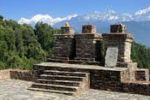
When the administrative headquarters of Sikkim were switched from Yuksom: the first state capital, they were shifted to Rabdentse. Rabdentse retained its position as the capital of former Sikkim state till 1814. The ruins of Rabdentse are located very close to the famous Pemayangtse Monastery in west Sikkim. A small trek of nearly 2 kilometers through dense jungles will reach you to this archeological site. This trek route starts at Pelling and extends till Geyzing.
Namgyal Institute
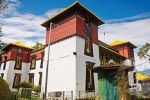
The Namgyal Institute of Tibetology is the quintessential asylum to learn the Tibetan traditions and culture. Considered amongst the Mahayana Scholars to be the highest throne of learning, this institute has become the prominent center for the study of Buddhist Philosophy and religion. Established in the year 1958, Namgyal Institute houses the world's largest collection of rare manuscripts and books on the Mahayana Buddhism theme. The institute also harbors a museum where more than 200 Buddhist icons, Thangkas, antique paintings, Tapestries, Statues, Shrines, masks and other religious works of Tibetan Art are exhibited. The Institute also boasts of a mighty collection of more than 30,000 books, most of them in xylographs. Xylographs mean the document printed on wooden slabs. The translations of the original preaching of the Lord Buddha and discourses made by eminent Buddhist scholars from the entire world are also accommodated in this prestigious institute.
Kabi Lungchok
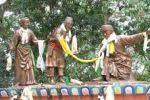
Kabi Lungchok, located about 17 km from the centre of Gangtok, is a place carrying a vital historical significance. This is the very site where the legendary treaty between the Bhutia chief Khey-Bum-Sar and Lepcha chief Te-Kung-Tek was signed. To mark the occasion, a huge stone pillar and statue was set up amidst the lush greenery of this place.
Institute of Tibetology
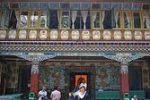
'The Institute of Tibetology' established on 10th February, 1957 by the 14th Dalai Lama, is one of the leading hubs in Gangtok for studying the voluminous collection of rare Lepcha, Tibetan and Sanskrit manuscripts, ancient statues, and Thankas (colourful tapestries). Declared open for public visits by Pandit Jawaharlal Nehru, this institute also houses an affluent museum where more than 200 Buddhist icons and many more treasured artistic objects are displayed. The Institute is known in every corner of the world for its architectural splendor and for being the global center for Buddhist religion and Philosophy studies.
Fambong la Wildlife Sanctuary

Located about 20 km from the heart of the city Gangtok, the Fambong la Wildlife Sanctuary is very well known for its comprehensive variety of flora and fauna. A pristine collection of plants like orchids, oak, bamboo, ferns, katus, kimbu, champa, rhododendrons, and so on and animals like binturong or bearcat, civet cat, Himalayan black bear and red panda are the noteworthy features of this profound wildlife sanctuary. This forest reserve is also a home to various species of birds and butterflies. It is a breath taking experience to observe the wild animals roaming around freely in their natural wild habitat in the Sanctuary. Nature reveals itself in its wildest form here and so this place is very much adored by the environmentalists.
Pelling

Located about 20 km from the heart of the city Gangtok, the Fambong la Wildlife Sanctuary is very well known for its compreLocated about 125 km away from Gangtok, Pelling offers a breathtaking view of the Kanchenjunga and adventure opportunities like trekking, skating, skiing etc.
Yuksom

The word Yuksom means 'the meeting point of three Lamas'. Yuksom, the first state capital of Sikkim, is located at an altitude of 1780 meters above Sea level. Situated about 33 km from Pelling, this is the popular base for the mountain climbing expeditions for the peaks in Kanchenjunga. The famous waterfalls named 'Phamrong Waterfall' are situated near Yuksom. Apart from this some other scenic destinations like, Coronation Throne, Dubdi Monastery, Kartok Lake, etc are major attractions of this place.
Nathu La Pass
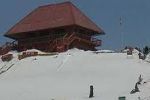
Situated on the Old Silk Route, about 12 km from Tsongo Lake and 50 km from Gangtok, Nathu La Pass is perched at the altitude of 14,000ft. This hill top has earned the reputation of being one of the most exotic places and a must visit tourist destination in Sikkim. The magnificent hills encircling the narrow terrain of Nathu La Pass renders a heavenly charm to the place. Nathu La Pass is the only place in India where you can see the Chinese soldiers across the International Border. Photography is strictly prohibited here and the soldiers will take away your cameras and return them only on return.


